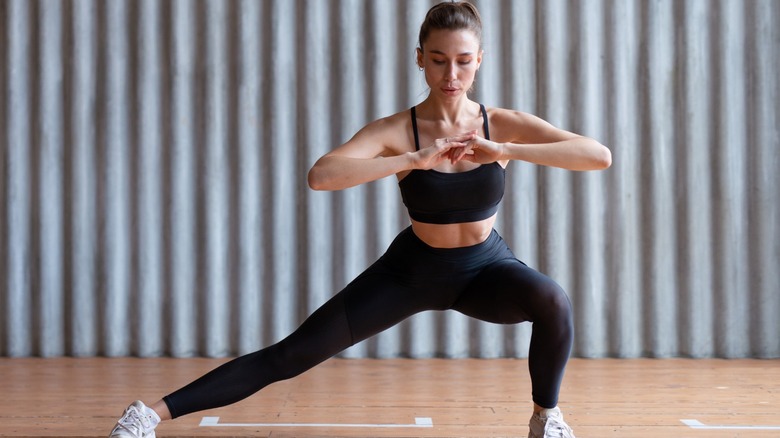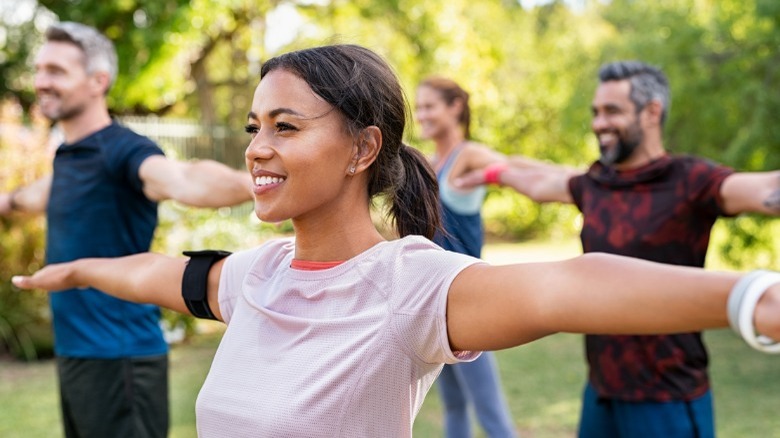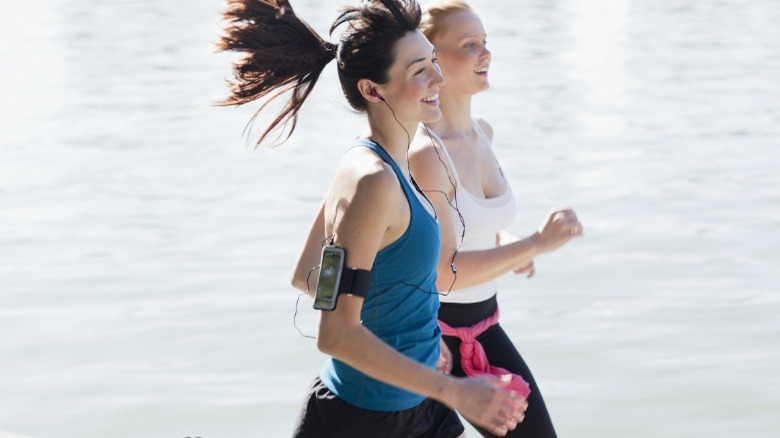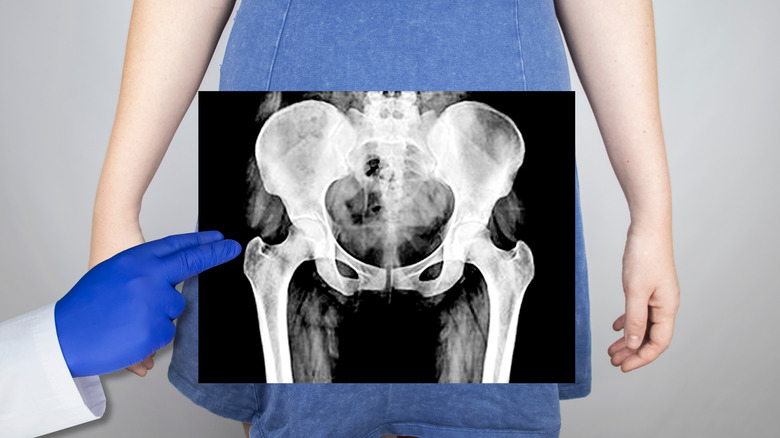All The Great Benefits Of Lateral Exercises
Situps, pushups, and lateral workouts, oh my! You're probably familiar with the first two — and maybe have given them a go — but if lateral exercises are new to you, it's time the two of you got acquainted. This type of workout is defined by any movement that involves shifting your body side-to-side, such as side lunges or banded walks, per Reviewed. Lateral exercises range in difficulty level, from nice and breezy to oh-my-god-how-am-I-sweating-this-much. If working out isn't your thing, we highly recommend giving them a try.
Exercising on a regular basis can significantly boost your mood and even help tamp down symptoms of depression and anxiety, according to the Mayo Clinic. If you aren't sure where to start, may we suggest lateral exercises? They offer a ton of great benefits, so if you've been thinking about improving your physical and mental health, as well as your energy levels, here's your sign to get up and start.
Lateral exercises improve balance and coordination
One of the key benefits of lateral exercises is they enhance your balance, stability, and coordination. Because you have to keep yourself upright during these movements, you're ultimately bettering your ability to hold yourself up for any period of time. To build stability, Active suggests lateral step-ups, single leg touchdowns, and the ice skater, to name a few. And through improving your balance, lateral exercises can help prevent injury, UltraSlide states. For example, if you're holding a yoga pose and start to lose control of your body, you'll have a better chance of staying upright and preventing your ankle from rolling if you regularly practice lateral movements.
There are several situations where stability and coordination can save you from injuring yourself — such as ice skating or hiking on a steep incline — but having better balance can make your day-to-day life much easier too. If you needed a reason to start lateral workouts, we can confidently say this may be one of the most important.
You can increase your deadlift weight
Lateral exercises can vastly improve your frontal plane strength, which in turn increases your weight capacity for heavy compound lifts, Muscle & Fitness explains. When you're performing deadlifts or squats, you need your frontal plane — the area where your front half meets your back half — to keep your body stiff in order to maintain proper form and prevent yourself from sustaining injuries. By sticking to a strict lateral workout schedule, you'll start to notice a more stabilized frontal plane, which means you're less likely to lose energy during squats and lifts.
Think of your frontal plane like a bike tire: The weaker it is, the less weight it can hold, and after a while, it will eventually deflate. However, when your bike tire is strong, it can withstand a good amount of weight without losing any air. Basically, lateral exercises are highly beneficial for those training for deadlift competitions, bodybuilders, or really anyone looking to increase their overall strength.
These exercises strengthen your muscles
It shouldn't come as a surprise lateral exercises strengthen your leg muscles, particularly those in the upper legs: your quads and hamstrings. "By implementing lateral movements, you're isolating one side, and the small muscles and tendons in the area at one time, allowing them to adapt, grow, and strengthen," says ACE-certified personal trainer Tami Smith via Reviewed. The more you work your leg muscles, the stronger they'll get. It's essentially the same as lifting free weights; you're isolating one arm from the other in order to work those specific muscles, which builds upper-body strength.
Side lunges are an excellent example of a lateral exercise that focuses on one half of your body at a time. As you lean to one side, you're putting a majority of your weight on your thighs, which helps them build muscle. You're also stretching your inner thighs, and by doing so, you're significantly increasing your flexibility, says Healthline. This means you're gaining muscle and flexibility all in one exercise!
Lateral movements improve your efficiency and speed
This is one benefit you may not have thought of, and it's a really good one — improving both your speed and efficiency. You might notice this in particular if you participate in exercises like trail running or hiking where you have to move your body in a variety of ways as you negotiate an uneven landscape. By doing lateral exercises, you'll strengthen the muscles in the hips, glutes, core, and back that you use to engage in lateral and transverse (rotating) motions — and over time you'll be able to perform these motions more easily and swiftly.
To really build these muscles, your greatest option is any lateral exercise that focuses on controlled movements, Laura Norris Running states. If you're preparing for a marathon or even a half-marathon, you might be focused on endurance cardio; however, incorporating lateral moves into your training is just as important.
They also stabilize your hips and pelvis
Last, but certainly not least, another benefit of lateral exercises is they help stabilize your pelvis and hips, which play an important part in improving your physical health and making your body the best it can be. Hip stabilization, in particular, also stabilizes the joints in your knee, which lessens your risk of knee pain, says Foothills Sports Medicine. Knee pain stems from not just an unstabilized hip joint, but weakened muscles in that area as well, including the gluteus medius, gluteus minimus, and the tensor fascia latae, per 3D Muscle Lab.
A stabilized pelvis is necessary to properly support your spine, Community Chiropractic & Acupuncture of Park Slope explains. Lateral workouts strengthen the sacroiliac, pubic symphysis, and the iliofemoral (hip) joints. When your pelvic joints have no stabilization, they end up moving all over the place, which means your spine is doing the same. In short, a stable pelvis equals a stable, healthy spine.





